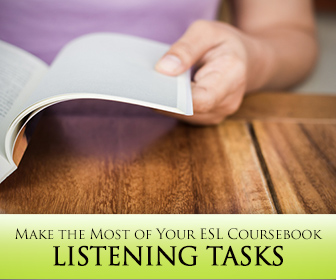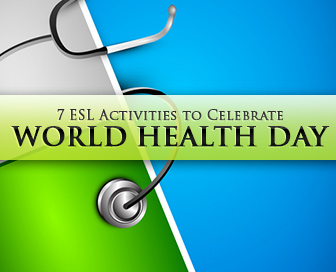ESL Coursebook Listening Tasks: 6 Steps to Make the Most of Them


Whether you have young learners or adult students, this is a great day to not only review the importance of healthy eating habits and general fitness, but also teach new, health-related vocabulary. In the true spirit of Health Day, you may choose to get them out of their seats and get their blood pumping, or enjoy some quiet, but thoroughly interesting sit-down activities. Try these fabulous activities for Health Day!

When you’re teaching very young ESL learners, you can’t talk about health without talking about body parts, first. Try this fun game so they can practice body parts and get a good, healthy workout. First, you’ll need to take some masking tape and make several crosses with it, around the classroom floor – make sure there is at least one X for each student and that there is enough space between them. Each student must stand on an X. Call out different commands: put your left foot on the X; put your right hand on the X. Then, move on to actions: jump up and down on your X; jog on your X; and so on.
The Food Pyramid is a classic in any health lesson plan, something that is educational for students of all ages and cultures. The US Department of Agriculture has developed some amazing booklets with printable worksheets and several activities you can do in class or assign for homework. There are booklets for Grades 1 and 2, 3 and 4, and 5 and 6 – be sure to check out which is more appropriate for your students’ English level. To accompany the booklets, the USDA has also provided a fabulous game called Pyramid Go Fish, which comes complete with 116 color flashcards.
Health Day is a great opportunity to review the kinds of problems we may have and ways to communicate them to a doctor. First, teach or review the most common health problems. Brainstorm some possible solutions/remedies for these ailments. Then have students work in pairs taking turns being either doctor or patient. Patients tell the doctor what their problem is and the doctor makes the appropriate recommendation (trying to remember the solutions that everyone came up with as a group). This is also a great opportunity to review the use of modals like “should”, “ought to”, “have to” and “must”, as well as adverbs of definite frequency like “once”, “twice”, “four times a day”, etc.
Patient: I have a bad cough.
Doctor: You should take this cough syrup three times a day.
Another great way to celebrate Health Day is with an energetic game of tag. Naturally, this works best if you have access to a gym or outdoor area your students can run around in – they’ll need lots of space! If possible, separate the playing field with some plastic cones so the children won’t bump into walls, trees or other obstacles. Divide the class into taggers and dodgers. Call out a body part (arm, back, knee, etc….) and the taggers have to tag the dodgers on that specific part. Dodgers must avoid being tagged. Once a dodger has been tagged, he/she has to freeze. Another dodger may unfreeze them, but they must tag them on a different body part. Make the game more challenging by calling out different body parts every minute or so.
A healthy lifestyle involves a lot more than eating right and exercising. Use this worksheet with your class to talk about which foods are healthy/unhealthy and explore different types of healthy/unhealthy habits. Finish with a discussion about what changes each of them can make to their lifestyle to live a healthier life.
Are you as fit as a fiddle? Do you eat like a horse? Or like a bird? These are interesting and fun idioms to teach your adult or advanced learners. IdiomConnection has a very complete list of medical and health idioms to choose from.
Every year the WHO picks a different theme, an area that is a health concern in today’s world. For 2013, the theme is high blood pressure. The WHO has a very informative page on the subject, which you can read with your adult learners. There is also some very good information in MedlinePlus. Whatever source you choose to read, be sure to start with a warm up to introduce the topic: “Have any of you ever suffered high blood pressure? What do you usually do to avoid this problem.” Then introduce the vocabulary (from the text) that may be new to students. Finally, have them take turns reading out loud, and finish off the lesson with some comprehension questions followed by a discussion.
When students learn English they are mostly exercising their minds. Give them a lesson that can help them improve their overall fitness and health!